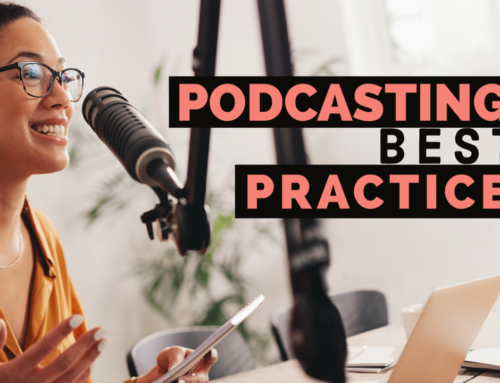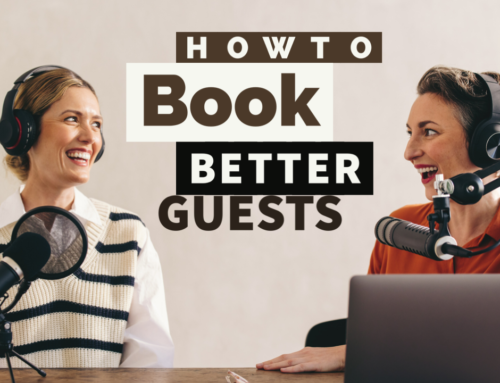7 Ways to Make Your Podcast More Interesting
Learn how to stand out and drive your podcast to the top.
There are roughly one million active podcasts and tens of millions of individual episodes as of 2022. The reality is that there is a lot of noise out there, so how do you differentiate your podcast from the rest? Do you sometimes feel like you’re letting your audience down? Do you get redundant or predictable? Looking for a way to switch it up a bit?
Your content must stand out if you’re going to be successful.
If you’re reading this, then you likely are seeking long-term results. You yearn to create a loyal following that eagerly awaits the next episode to appear on your feed. An engaged audience knows if you release a show late, they give good and honest reviews and share your content with their community and networks.
Consistent, engaging episodes encourage your fans to listen habitually, which is essential for building the community that you seek.
It doesn’t matter how well-edited or produced your show is if you don’t get this right. Once you find your groove, and then you pair that with the unbeatable post-production services offered at The Post Production Shop, you will be positioned for success.
Here are 7 rock-solid ways to make your podcast more interesting:
#1 Engage the Audience
Even though this first tip may seem simple, it is very important. You must immerse your audience in a compelling conversation, involve them in building your show, and interact on various platforms to keep your listeners truly engaged. Many amateur podcasters miss the mark here.
Don’t be monotone, boring, or insecure while sitting behind the mic.
This is an unfortunate way to never amass a following and not be taken seriously. Your main goal should be to keep your audience engaged at all times. With that being said, stuttering, restating sections that didn’t sound good, pausing too long, or rushing – are all things that can be fixed after the initial recording. You really shouldn’t be anxious about them – just lean into the delivery and performance of your show and be the host that you would love to listen to yourself.

Introduce new segments or experiment with different episode formats.
There are many types of ‘segments’ or ‘formats’ that can be incorporated for something different. One idea is to provide listeners with a tool to record messages for the show, which can then be played in a follow-up episode. You can achieve this by using a Google Voice number, with a voicemail box for the audience to call in to. This can create a radio-quality segment, like a call-in show. The segment can then be assembled all after the initial recording, to create a unique and sometimes spontaneous segment.
Use well-placed music.
Music is not only great for compelling intros and outros but also works as a superior transition tool throughout the show. Add a transition between a guest finishing an answer and the next question – or perhaps between a monologue introduction and the beginning of the interview. Music adds a strong production element to your show and helps prevent your podcast from sounding too plain and becoming background noise for the listener.
Pro Tip: Sound effects can be used in a similar way as music, but be careful not to overdo it! They can be used for comedic purposes, to build suspense and anticipation, or to tell a story. Sound effects can be overpowering, but occasionally a well-placed sound effect fits quite nicely.
Encourage your audience to leave comments on social media or their preferred podcatcher.
Make sure to respond to as many comments as possible, as this builds a bond with your audience. Encourage listeners to leave reviews and read your favorite ones on the show. Your best and most engaged listeners will be excited to hear their comments read on the show and will be encouraged to leave positive and well-written reviews.
#2 Keep your podcast updated
Your feed is an archive of all your content. Anyone will be able to access it years into the future and discover old episodes as if they were brand new. Except one thing… all of your extra segments – intro/outro monologues and ads specifically – are now dated and stale.
Either the ads are expired and you don’t even promote those products anymore, or the production quality is lacking. If someone happens to click on an episode with subpar audio quality (because let’s face it, everyone accidentally records with the built-in laptop mic at least once), they may dismiss your entire show as having poor quality. This can be frustrating, especially when you now pride yourself on this.
Select a distribution platform like Spreaker
Spreaker* allows you to swap in new and current segments within old episodes. This means that if a listener puts on your first episode from 8 years ago, they can actually hear current ads that still have the potential to make you money, and also an updated and more engaging intro. Using an up-to-date into is particularly useful because for welcoming new listeners to your show, recommending current episodes or listener favorites, or sending them wherever you need. Get creative with this.
Don’t delete your early “demo” episodes, just repurpose them.
Early interviews can be reworked and revisited. A guest returning is a great time to direct your listeners to an older episode with a great interview, or reuse sound clips that are relevant to a current episode.
*We don’t make any money from recommending Spreaker by the way – we just really like this idea. And yes, you can switch to Spreaker at any time – it’s extremely easy, regardless if you’re already set up with a different distribution company. (And if you know of any other great platforms that offer similar services, please let us know!)

#3 Choose guests wisely
Your guest choices matter – a lot.
Choose guests who are not only subject matter experts but are also great storytellers.
Storytelling can ignite compelling conversation no matter the subject. Search for guests who have a good presence and can deliver their own story well. People who are passionate about what they do will naturally present more engaging material that will keep your listeners tuning in.
Know as much as possible about your guest and their niche before the interview.
Preparation will help you form interesting questions before the recording starts. Being familiar with their work and opinions prior to the interview will also guide well-formed follow-up questions while challenging them to come up with unique answers they haven’t necessarily given elsewhere. People who are interviewed often enjoy when they are asked a question they haven’t been asked before. So be creative! Don’t be afraid to occasionally ask something out of the box, so long as it is appropriate.
Try out having multiple guests on at the same time.
Whether interviewing both simultaneously or just having a free-flowing conversation, this can give an interesting dynamic. Especially if you don’t do it often, having 3 or more people on the same episode is guaranteed to switch it up.
Pro Tip: Try a service like Riverside for recording multiple guests. If you record both guests through the same Skype or Zoom channel, they will be on the same track, talking over each other and causing spotty audio quality at best. Riverside will record each speaker on their own track, making the final episode easier to understand and sound better overall.
If recording multiple guests simultaneously seems daunting, you may interview the different guests individually at separate times and then assemble the segments together afterward. This format is best suited for presenting a holistic view of a given topic, and it will help make your podcast seem authoritative.
#4 Invest in yourself and your show
Do you ever discover a new podcast, get all excited that it’s just what you were looking for, then hit play and find yourself completely underwhelmed? Such a bummer…
You must invest in your podcast and yourself so that listeners never have this reaction to one of your episodes. It’s up to you to find the best combination of these factors but a little of each will go a long way.
Quality equipment is essential.
Are you using a basic USB mic, or do you have a reliable microphone (something in the $100 range)? Every microphone will add its own vibe to your show. Some mics do well in any setting, while others are not a good fit for dialogue. In general, most microphones will work just fine and many of the differences between them are just personal sound preferences.

You don’t want a mic so cheap that it gives your audience the feeling you’re not professional.
On the other hand, while everyone wants a nice, expensive microphone, is it really worth it?
Yes and no. While it does make a difference, the returns are diminishing. A $1,000 microphone will definitely sound better than a $100 dollar microphone, but not necessarily 10 times better. So every podcaster must find balance and choose the microphone that works best for their own situation.
For most podcasters, the $100 range is exactly where they should be: professional, but not broke.
Professional audio editing services will make your podcast sound crisp and polished.
A skilled editor will expertly remove stutters, filler words, mumbles, and redundancies while ensuring that the pacing and cadence are just right. This will make you and your guests sound more knowledgeable and well-spoken, and also keep the listener’s attention by minimizing dead space and difficult-to-follow sections. In the end, a fully edited episode will only be a couple of minutes shorter than the raw version, yet it will feel to the audience like it flew by.
Well-edited podcasts will keep your listeners coming back for more.
As beneficial as professional editing can be, there are different levels of detail and price. Podcasts just starting out, generally do a lighter edit. As advertisement money and/or donations begin to come in, more investment can be made toward editing. Full-detail editing will provide the most professional and polished result possible.
Be smart and balanced about your investments!
A decent microphone and some basic editing are early priorities. After that could be anything from marketing software, to an online public speaking course, or even traveling to a conference within your specific niche. There are countless ways to invest in yourself and your podcast.
#5 Add video
Only roughly 20% of podcasts today are using video. While this number is growing, it is an opportune time to make the leap to offering video to your listeners. Adding great video helps differentiate shows that use a mainly audio-based medium. The video podcast niche is growing, but unfortunately, so many of these video podcasts are lacking professional audio quality.
Stand out with a show that both looks and sounds good.
Audiences connect with visual content. The ability to see a person while they are speaking is an instant attention grabber. But just like for audio, it is important that you invest in your video production setup as well. The production quality of a well-done video with spot-on audio will make your show stand out and your following grow.
Invest in quality video equipment.
Have a quality camera and tripod, good lighting, and an intentional backdrop. As your show grows, consider investing in professional video editing also. The Post Production Shop can help transition any podcast to a video podcast. Contact us here if you have questions on how to begin.
Video is ideal for social platforms.
Video allows short excerpts or clips from episodes to be shared directly with your audience on many social media platforms. It is a reasonable expectation that the use of video will continue to increase far into the future, so be sure to consider it when you’re ready.
Want to learn more about starting a video podcast? Read 5 Mistakes to Avoid When Starting Your Video Podcast
Pro Tip: Only 10% of podcasts do live-streaming, which makes for a huge market opportunity and a great way to stand out from the crowd. Consider doing an occasional live stream. It can be as simple as streaming for 20 minutes with a thought of the day, an impromptu interview, or scheduling an official Q&A.

#6 Prepare for each episode before recording
Keep your audience connected and listening every week by preparing before each recording
Plan your questions in advance.
It’s a rare thing for a host to wing it and not look amateurish. Have a couple of extra questions too in case the interview is shorter than expected and you need more material. Be sure to share your questions with the guest in advance so they can be prepared too. You don’t have to share every last question but a rough outline will make them more confident going into the interview and encourage better answers.
Develop your skills and knowledge.
Once you develop your skills and knowledge, you will be able to perform with less preparation. But as you are working toward that, be sure you prepare adequately to avoid sounding uninformed or inexperienced (especially while trying to sound the opposite).
Educate yourself on the topic thoroughly by finding facts, statistics, experiences, and stories.
Have some bullet points written down to pivot quickly if needed. Some hosts approach podcast interviews like they would a job interview. When it comes to being familiar with your guest and the subject matter beforehand, it’s difficult to be too prepared.
Create a pre-recording checklist for yourself
Quickly ensure you’re ready to go before hitting Record. For instance:
-
The pop filter is in place
-
Mic input level is well into the green
-
The headphones’ volume is comfortable
-
The guest is ready to be recorded
-
A concise intro is prepared (or sometimes written out)
-
The guest’s bio is ready and understood
-
Questions / pre-show notes
7. Improve your speaking skills
Your manner of speaking, vocabulary, and confidence are all essential to the success of your podcast. Of course, you already love speaking and are likely pretty good at it – hence why you’re a podcaster!
Even the best speakers have room for improvement.
An uncomfortable truth is that most people, guests and hosts alike, tend to not be readily aware of the areas where they most need improvement. Critiquing your own voice is one of the most difficult things to do objectively. There are many methods to improve speaking, delivery, and overall presence on the show, which are guaranteed to make your podcast more interesting to listen to.
Search for resources on improving vocal delivery.
The good news is that there are very easy ways to improve your vocal delivery, which will go a long way toward expanding your reach. The first step is to start with free resources; blogs, podcasts, or videos on the subject. There are plenty out there to get you started. Simply search things like:
-
“How to be a better podcast host”
-
“How to say um less often”
-
“How to enunciate better”
Compile the best suggestions that fit your situation and work to improve one thing at a time.
Read books on public speaking or take an online course about speaking with confidence. If you work through these resources and still feel like much improvement is needed, you may find value in hiring a personal coach or speech coach to achieve your goals.
So, there you have it! Seven ways to make your podcast more interesting: Engage the audience, keep your podcasts updated, choose your guests wisely, invest in yourself and your show, add video, prepare for each episode before recording, and improve your speaking skills.
If you need assistance or your podcast is ready to be edited, contact us here.




